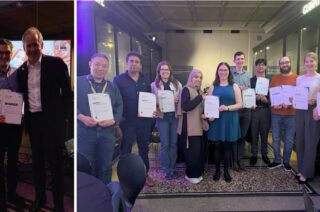Meet Teaching Excellence award winner Lisa Taylor

Lisa Taylor is a Senior Lecturer in Fashion Business and Technology in the Department of Materials. She led the Fashion Education and Inclusive Learning Innovators (FEILI) team that won the Inclusive Education and Flexible Learning and Digital Delivery award at the 2024 Teaching Excellence Awards for their Digital Learning Technologies Project: a Creative Combination to Augment Applied Learning. Here she tells us more about the project and what the future might hold.
How the project came about
When I started teaching garment technology, only 25 students were enrolled and it was an optional module. I was surprised as coming from industry, I know that garment technology is fundamental to the field, even if you’re not going to specialise in it. Over time, the curriculum shifted, and garment technology became a core subject. However, this shift created new challenges, especially with larger class sizes, and students were finding it tough to connect the theory from class with the hands-on skills they needed in workshops. Feedback from students showed that they often needed a lot of guidance just to get comfortable with new skills usually while juggling coursework deadlines too.
I wanted to create something that could take some of the pressure off both students and teaching staff. By putting the basics online, students can get to grips with key skills in their own time so when they’re in class, we can dive into more advanced areas. It also means lecturers and Graduate Teaching Assistants (GTAs) can spend less time covering the same ground and more time focusing on higher-level concepts.
Introducing the micro sewing site
The micro-sewing site is an accessible, centralised repository for students studying garment technology. Originally, I created it as a quick-access tool where students could find essential information without having to dig through excessive material. I wanted it to be straightforward to navigate and comprehensive, including all the information students need to apply their learning practically. It began as a QR code tool and then evolved into an elearning platform, the ‘micro sewing site’. This platform has become a space where students can access step-by-step guides, videos, and technical standards. It’s portable, accessible through Blackboard, and students can watch instructional videos or review technical content anywhere whether in the library, at home, or on the go. This flexibility has provided students with freedom to learn at their own pace, which is so important in a field where hands-on practice is vital.
“It has made my teaching experience much easier, as I know there is a reliable and comprehensive resource, I can direct the students to if they need extra help.”
The importance of sustainable practices
Sustainability is at the heart of what we’re trying to teach through this resource. When garments are made incorrectly, they often end up in landfill which is something I want to help prevent. Through the site, I emphasise getting it right from the start. We discuss garment fit, for example, which can lead to massive waste if done incorrectly. I’ve known of cases where entire batches of clothing were unusable due to poor fit. So, we’re not only focusing on practical skills but also encouraging responsibility to reduce waste and environmental impact.
Working with the eLearning team
Dan Jagger and Steve Davis were instrumental in bringing this project to life. While I provided the content, including scripts and written resources based on standards like British and international regulations, they handled the technical side of things including editing videos, organising material, and recording voiceovers. Steve’s voiceovers added a calming and authoritative tone, which has been well-received by students. Without their help, the project would have taken much longer to complete.
The future of the site
Seeing the positive feedback and success, I want to expand the platform further. My goal is to incorporate more British standards, especially around material joining and garment construction. I hope to make it an open-access resource so that students and professionals worldwide can benefit. A colleague at another university has a similar platform for pattern cutting, which has been used 80,000 times in Brazil alone. This kind of reach is incredibly inspiring, and I believe our micro sewing site has similar potential for the fashion industry.
“It has definitely positively impacted the learning experience, allowing students to go back to this information in the future as well as helping those who learn in different ways, offering videos and explanations as well as the in person practical sessions.”


